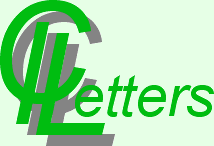
Volume 2, Issue 6; June 2001
Editor: Jonathan M Goodman
- Chemical Heritage Foundation
- The Chemical Heritage Foundation (CHF) promotes the heritage and public
understanding of the chemical and molecular sciences by operating the Othmer library,
a historical research library, and running the Beckman Centre for the history of
Chemistry.
- Synthesis Planning
- A list of synthesis planning programs, collated by
Koen van Aken
- Nucleic Acid Database
- The Nucleic Acid Database Project
(NDB) assembles and distributes structural information about nucleic acids.
- Cheminformatics Course at UMIST
- The chemistry department at UMIST
have started a new cheminformatics MSc course. The course is full time, but
it is anticipated that the course will become
available via a distance learning route. It is being run by
Dr Andy Whiting and
Dr Brian Booth
- Cheminformatics and Rensselaer Polytechnic Institute
- The Rensselaer Polytechnic Institute runs a cheminformatics course
from its IT department.
- World Wide Web Consortium Issues XML Schema as a W3C Recommendation
- Two years of development produces a comprehensive solution
for XML vocabularies: XML Schema
What is the difference between DTDs and Schemas?
Ds are rules on how the document is to be "formatted". In other words, where certain
elements and tags are to be placed within a document. This refers to the document's
structure. Eg HTML, BODY
As long as those are in the correct order (as specified by the DTD), the
document is "verified" correct by a validating parser. Yet, this has nothing to do with the
data between those tags.
This is where schemas come in. They represent a validation against not only the document's
structure, but also the data it contains. You could liken it to
the constraint on a database table's field. I.e., CustomerType = V or I (Valid, or Invalid). To
continue the example from above, you could specify a schema the restricts the content of the
data between the html and body tags.
- PubGene
- New Scientist:
Biologists in Norway have used a computer program to "read" the
scientific literature and successfully predict gene interactions.
This data-mining of the "biobibliome" provides a way of dealing with the
ever-increasing torrent of biological data - millions of papers a year. But
even more impressively, the completely automated process can make
new genetic discoveries - essentially free research.
- State Academies of Science Abstracts
- Covers journal of USA state academies, including chemistry. Must pay to get the information
- Free net
- Freenet is a large-scale peer-to-peer network which pools the power of member computers
around the world to create a massive virtual information store open to anyone to freely publish or
view information of all kinds. Now beginning to develop an
SQL interface.
- Chemical Informatics Notes
- Lecture notes on chemoinformatics by
Dr Christoph Steinbeck of the
Max-Planck-Institute
of Chemical Ecology
- Rosetta Inpharmatics
- Rosetta Inpharmatics producecs informational genomics solutions.
Its mission is to innovate and integrate
technologies in computational and molecular biology to catalyze
discovery for the life sciences industry.
It has just been bought by Merck.
- Spectroscopy Now
- On line resource serving spectroscopy, including:
Mass Spectrometry (incorporating Base Peak)
X-ray Spectrometry
NMR (incorporating NMR Knowledge Base)
Chemometrics (incorporating Chemometrics World)
© 2001 J M Goodman, Cambridge










